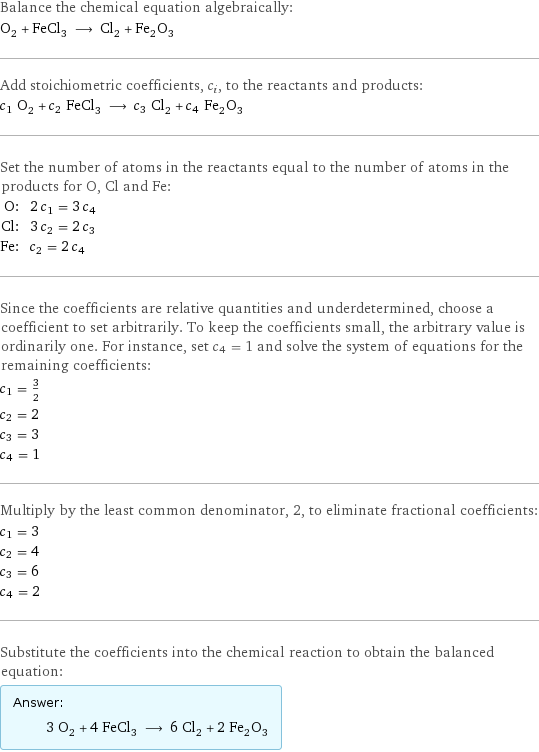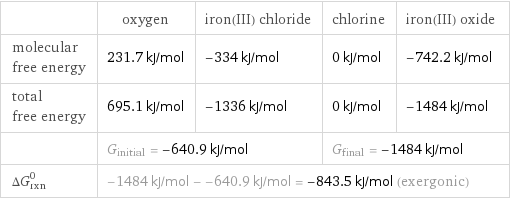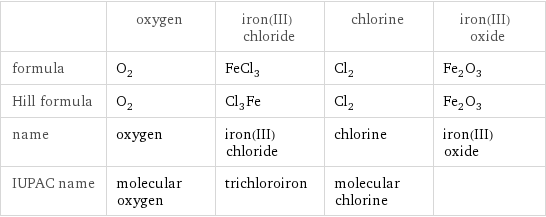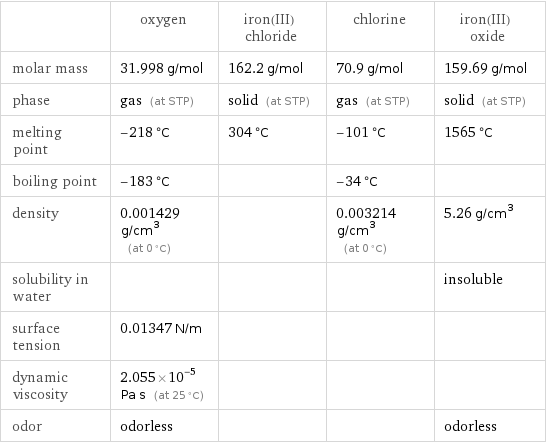Input interpretation

O_2 oxygen + FeCl_3 iron(III) chloride ⟶ Cl_2 chlorine + Fe_2O_3 iron(III) oxide
Balanced equation

Balance the chemical equation algebraically: O_2 + FeCl_3 ⟶ Cl_2 + Fe_2O_3 Add stoichiometric coefficients, c_i, to the reactants and products: c_1 O_2 + c_2 FeCl_3 ⟶ c_3 Cl_2 + c_4 Fe_2O_3 Set the number of atoms in the reactants equal to the number of atoms in the products for O, Cl and Fe: O: | 2 c_1 = 3 c_4 Cl: | 3 c_2 = 2 c_3 Fe: | c_2 = 2 c_4 Since the coefficients are relative quantities and underdetermined, choose a coefficient to set arbitrarily. To keep the coefficients small, the arbitrary value is ordinarily one. For instance, set c_4 = 1 and solve the system of equations for the remaining coefficients: c_1 = 3/2 c_2 = 2 c_3 = 3 c_4 = 1 Multiply by the least common denominator, 2, to eliminate fractional coefficients: c_1 = 3 c_2 = 4 c_3 = 6 c_4 = 2 Substitute the coefficients into the chemical reaction to obtain the balanced equation: Answer: | | 3 O_2 + 4 FeCl_3 ⟶ 6 Cl_2 + 2 Fe_2O_3
Structures

+ ⟶ +
Names

oxygen + iron(III) chloride ⟶ chlorine + iron(III) oxide
Reaction thermodynamics
Enthalpy

| oxygen | iron(III) chloride | chlorine | iron(III) oxide molecular enthalpy | 0 kJ/mol | -399.5 kJ/mol | 0 kJ/mol | -826 kJ/mol total enthalpy | 0 kJ/mol | -1598 kJ/mol | 0 kJ/mol | -1652 kJ/mol | H_initial = -1598 kJ/mol | | H_final = -1652 kJ/mol | ΔH_rxn^0 | -1652 kJ/mol - -1598 kJ/mol = -54 kJ/mol (exothermic) | | |
Gibbs free energy

| oxygen | iron(III) chloride | chlorine | iron(III) oxide molecular free energy | 231.7 kJ/mol | -334 kJ/mol | 0 kJ/mol | -742.2 kJ/mol total free energy | 695.1 kJ/mol | -1336 kJ/mol | 0 kJ/mol | -1484 kJ/mol | G_initial = -640.9 kJ/mol | | G_final = -1484 kJ/mol | ΔG_rxn^0 | -1484 kJ/mol - -640.9 kJ/mol = -843.5 kJ/mol (exergonic) | | |
Equilibrium constant
![Construct the equilibrium constant, K, expression for: O_2 + FeCl_3 ⟶ Cl_2 + Fe_2O_3 Plan: • Balance the chemical equation. • Determine the stoichiometric numbers. • Assemble the activity expression for each chemical species. • Use the activity expressions to build the equilibrium constant expression. Write the balanced chemical equation: 3 O_2 + 4 FeCl_3 ⟶ 6 Cl_2 + 2 Fe_2O_3 Assign stoichiometric numbers, ν_i, using the stoichiometric coefficients, c_i, from the balanced chemical equation in the following manner: ν_i = -c_i for reactants and ν_i = c_i for products: chemical species | c_i | ν_i O_2 | 3 | -3 FeCl_3 | 4 | -4 Cl_2 | 6 | 6 Fe_2O_3 | 2 | 2 Assemble the activity expressions accounting for the state of matter and ν_i: chemical species | c_i | ν_i | activity expression O_2 | 3 | -3 | ([O2])^(-3) FeCl_3 | 4 | -4 | ([FeCl3])^(-4) Cl_2 | 6 | 6 | ([Cl2])^6 Fe_2O_3 | 2 | 2 | ([Fe2O3])^2 The equilibrium constant symbol in the concentration basis is: K_c Mulitply the activity expressions to arrive at the K_c expression: Answer: | | K_c = ([O2])^(-3) ([FeCl3])^(-4) ([Cl2])^6 ([Fe2O3])^2 = (([Cl2])^6 ([Fe2O3])^2)/(([O2])^3 ([FeCl3])^4)](../image_source/b20cf965783d402930128583d2bff632.png)
Construct the equilibrium constant, K, expression for: O_2 + FeCl_3 ⟶ Cl_2 + Fe_2O_3 Plan: • Balance the chemical equation. • Determine the stoichiometric numbers. • Assemble the activity expression for each chemical species. • Use the activity expressions to build the equilibrium constant expression. Write the balanced chemical equation: 3 O_2 + 4 FeCl_3 ⟶ 6 Cl_2 + 2 Fe_2O_3 Assign stoichiometric numbers, ν_i, using the stoichiometric coefficients, c_i, from the balanced chemical equation in the following manner: ν_i = -c_i for reactants and ν_i = c_i for products: chemical species | c_i | ν_i O_2 | 3 | -3 FeCl_3 | 4 | -4 Cl_2 | 6 | 6 Fe_2O_3 | 2 | 2 Assemble the activity expressions accounting for the state of matter and ν_i: chemical species | c_i | ν_i | activity expression O_2 | 3 | -3 | ([O2])^(-3) FeCl_3 | 4 | -4 | ([FeCl3])^(-4) Cl_2 | 6 | 6 | ([Cl2])^6 Fe_2O_3 | 2 | 2 | ([Fe2O3])^2 The equilibrium constant symbol in the concentration basis is: K_c Mulitply the activity expressions to arrive at the K_c expression: Answer: | | K_c = ([O2])^(-3) ([FeCl3])^(-4) ([Cl2])^6 ([Fe2O3])^2 = (([Cl2])^6 ([Fe2O3])^2)/(([O2])^3 ([FeCl3])^4)
Rate of reaction
![Construct the rate of reaction expression for: O_2 + FeCl_3 ⟶ Cl_2 + Fe_2O_3 Plan: • Balance the chemical equation. • Determine the stoichiometric numbers. • Assemble the rate term for each chemical species. • Write the rate of reaction expression. Write the balanced chemical equation: 3 O_2 + 4 FeCl_3 ⟶ 6 Cl_2 + 2 Fe_2O_3 Assign stoichiometric numbers, ν_i, using the stoichiometric coefficients, c_i, from the balanced chemical equation in the following manner: ν_i = -c_i for reactants and ν_i = c_i for products: chemical species | c_i | ν_i O_2 | 3 | -3 FeCl_3 | 4 | -4 Cl_2 | 6 | 6 Fe_2O_3 | 2 | 2 The rate term for each chemical species, B_i, is 1/ν_i(Δ[B_i])/(Δt) where [B_i] is the amount concentration and t is time: chemical species | c_i | ν_i | rate term O_2 | 3 | -3 | -1/3 (Δ[O2])/(Δt) FeCl_3 | 4 | -4 | -1/4 (Δ[FeCl3])/(Δt) Cl_2 | 6 | 6 | 1/6 (Δ[Cl2])/(Δt) Fe_2O_3 | 2 | 2 | 1/2 (Δ[Fe2O3])/(Δt) (for infinitesimal rate of change, replace Δ with d) Set the rate terms equal to each other to arrive at the rate expression: Answer: | | rate = -1/3 (Δ[O2])/(Δt) = -1/4 (Δ[FeCl3])/(Δt) = 1/6 (Δ[Cl2])/(Δt) = 1/2 (Δ[Fe2O3])/(Δt) (assuming constant volume and no accumulation of intermediates or side products)](../image_source/032b2a742c880f9d3f3f94669dddc0b2.png)
Construct the rate of reaction expression for: O_2 + FeCl_3 ⟶ Cl_2 + Fe_2O_3 Plan: • Balance the chemical equation. • Determine the stoichiometric numbers. • Assemble the rate term for each chemical species. • Write the rate of reaction expression. Write the balanced chemical equation: 3 O_2 + 4 FeCl_3 ⟶ 6 Cl_2 + 2 Fe_2O_3 Assign stoichiometric numbers, ν_i, using the stoichiometric coefficients, c_i, from the balanced chemical equation in the following manner: ν_i = -c_i for reactants and ν_i = c_i for products: chemical species | c_i | ν_i O_2 | 3 | -3 FeCl_3 | 4 | -4 Cl_2 | 6 | 6 Fe_2O_3 | 2 | 2 The rate term for each chemical species, B_i, is 1/ν_i(Δ[B_i])/(Δt) where [B_i] is the amount concentration and t is time: chemical species | c_i | ν_i | rate term O_2 | 3 | -3 | -1/3 (Δ[O2])/(Δt) FeCl_3 | 4 | -4 | -1/4 (Δ[FeCl3])/(Δt) Cl_2 | 6 | 6 | 1/6 (Δ[Cl2])/(Δt) Fe_2O_3 | 2 | 2 | 1/2 (Δ[Fe2O3])/(Δt) (for infinitesimal rate of change, replace Δ with d) Set the rate terms equal to each other to arrive at the rate expression: Answer: | | rate = -1/3 (Δ[O2])/(Δt) = -1/4 (Δ[FeCl3])/(Δt) = 1/6 (Δ[Cl2])/(Δt) = 1/2 (Δ[Fe2O3])/(Δt) (assuming constant volume and no accumulation of intermediates or side products)
Chemical names and formulas

| oxygen | iron(III) chloride | chlorine | iron(III) oxide formula | O_2 | FeCl_3 | Cl_2 | Fe_2O_3 Hill formula | O_2 | Cl_3Fe | Cl_2 | Fe_2O_3 name | oxygen | iron(III) chloride | chlorine | iron(III) oxide IUPAC name | molecular oxygen | trichloroiron | molecular chlorine |
Substance properties

| oxygen | iron(III) chloride | chlorine | iron(III) oxide molar mass | 31.998 g/mol | 162.2 g/mol | 70.9 g/mol | 159.69 g/mol phase | gas (at STP) | solid (at STP) | gas (at STP) | solid (at STP) melting point | -218 °C | 304 °C | -101 °C | 1565 °C boiling point | -183 °C | | -34 °C | density | 0.001429 g/cm^3 (at 0 °C) | | 0.003214 g/cm^3 (at 0 °C) | 5.26 g/cm^3 solubility in water | | | | insoluble surface tension | 0.01347 N/m | | | dynamic viscosity | 2.055×10^-5 Pa s (at 25 °C) | | | odor | odorless | | | odorless
Units
